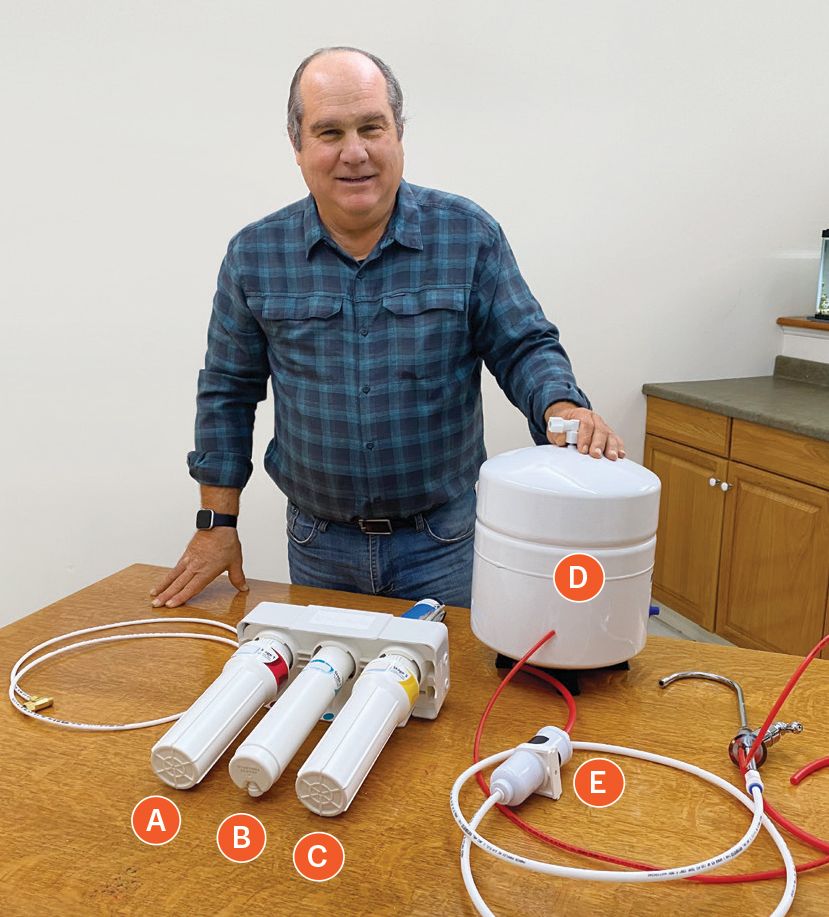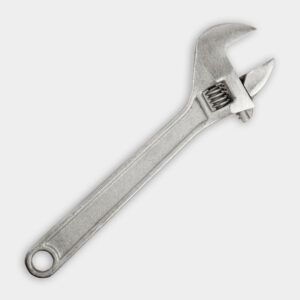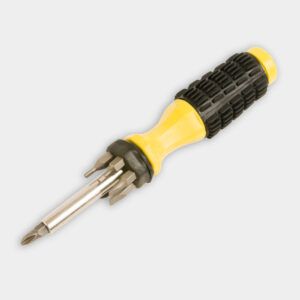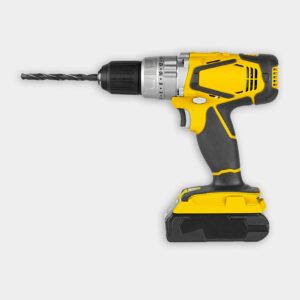We may be compensated if you purchase through links on our website. Our team is committed to delivering honest, objective, and independent reviews on home products and services.
Installing a reverse osmosis (RO) water filter can significantly improve the quality of your drinking water by removing contaminants and impurities and balancing its pH. This advanced filtration system is particularly effective at eliminating harmful substances such as per- and polyfluoroalkyl substances (PFAS), which are increasingly becoming a concern in many water supplies.
In the video above, Ask This Old House plumbing expert Richard Trethewey guides you through installing an under sink RO system so you can enjoy clean, great-tasting water at home.
Reverse Osmosis System Components

The RO process forces water through three stages of filtration. A prefilter (A) traps sediment that can make water cloudy and odorous. Activated charcoal (B) takes out most of the volatile organic compounds (VOCs), heavy metals like lead and cadmium, PFAS, and other chemical contaminants.
A third filter (C) contains layers of semipermeable membranes that trap whatever gets past the charcoal, so only purified H2O comes through. Because it takes time for water to make its way through all these filters, the system shown here has a small holding tank (D) to keep some liquid ready for use.
RO filtration also removes beneficial minerals that give water its taste. But those can be added back with a remineralizing cartridge (E), which restores water’s flavor before it reaches your glass.
Pro tip: Though they’re available, Trethewey doesn’t recommend whole-house RO systems because of their size, expense, and maintenance requirements.
Installing a Reverse Osmosis System
Installing an under-the-sink RO system is manageable for DIYers with basic plumbing skills. Below are Trethewey’s installation steps:
- Before beginning the installation, gather some basic tools such as a drill, screwdriver, and wrench. Then, clear the area under your sink and remove any items to make room for the installation.
- Turn off the cold water supply to avoid leaks during setup. Use the adjustable wrench to remove the hose stretching from the valve to the faucet (only remove it from the shut-off valve).
- Install the brass tee fitting that came in your RO kit. Use the wrench to tighten it onto the shut-off valve and reconnect the sink hose to the top side of the tee.
- Install the smaller plastic tubing to the tee using the included nut, compression fitting, and sleeve. Tighten the hose onto the tee with the adjustable wrench.
- Install the manifold. Hold it against the side of the cabinet and mark the holes with a pencil or marker. Predrill holes at these marks and thread screws into the holes with the screwdriver. Repeat the same process for the remineralizer, offset so that it won’t interfere with the manifold. Hang both the manifold and the remineralizer brackets from the screws and tighten them in place before installing the filters.
- Wrap the threaded nipple on the top of the tank with four or five passes of Teflon tape before installing the tank connector (the white plastic elbow). Hand-tighten this fitting over the Teflon before pushing the larger white plastic tubing all the way into the nut and tightening it with the wrench. Place the tank in the corner of the cabinet.
- Insert the rubber gasket in the bottom of the faucet base. Attach the larger red hose to the larger barb fitting and the smaller red hose to the smaller fitting. Feed the tubing through a hole in the sink or cabinet, and place the spacer onto the faucet from underneath before threading the nut and tightening it with a wrench. Attach the included hose connecter to the threads and push the large white hose into the fitting.
- Place the foam seal on the drain pipe and place the saddle over the hole, tightening with the wrench. Drill a 7/32-inch hole into the pipe, but do not drill through both sides.
- Connect all the tubing according to the diagram above, turn the water on, and check for leaks.
Maintenance and Upkeep of a Reverse Osmosis System
Regular maintenance keeps your RO system in top shape, ensuring clean water for years.
Filter Replacement
Most RO systems require filter changes every 6–12 months, depending on your usage and water quality. The RO membrane typically lasts 2–3 years. Follow the manufacturer’s recommendations for replacement schedules.
System Sanitization
Periodically sanitizing your RO system helps prevent bacterial growth. Use a sanitizing solution as recommended by the manufacturer, followed by thorough rinsing.
Water Quality Testing
Regularly testing your filtered water can help you monitor the system’s performance and keep it effective at removing contaminants.
Addressing Common Issues With Reverse Osmosis Systems
While RO systems are effective and reliable, they can have some common issues. Here’s how to handle the most common ones:
- Low water pressure: One common issue is low water pressure, which can reduce the efficiency of the RO system. Clogged filters or an issue with the water supply often cause this. Regular filter replacements should resolve this.
- Leaks: Leaks can occur at various points in the system, and they’re usually thanks to loose connections or worn-out parts. Regularly check connections and replace worn components to prevent leaks.
- Bad taste or odor: Even though RO systems are designed to improve the taste and odor of water, problems can still happen if you don’t replace the filters on schedule. Sticking to the manufacturer’s recommended filter replacement intervals can keep the water tasting fresh and clean.
Enhancing Your Reverse Osmosis System With Additional Features
Consider these add-ons to boost your RO system’s performance and convenience:
- UV sterilization: Adds extra protection against bacteria and viruses. This is great if you have well water.
- Permeate pump: Increases water flow and reduces wastewater, making the system more efficient. This can be a cost-effective upgrade for large households with high water consumption.
- Remineralization filter: Reintroduces essential minerals like calcium and magnesium, improving both taste and health benefits. Trethewey installs a remineralization filter for the homeowner in the video segment.




